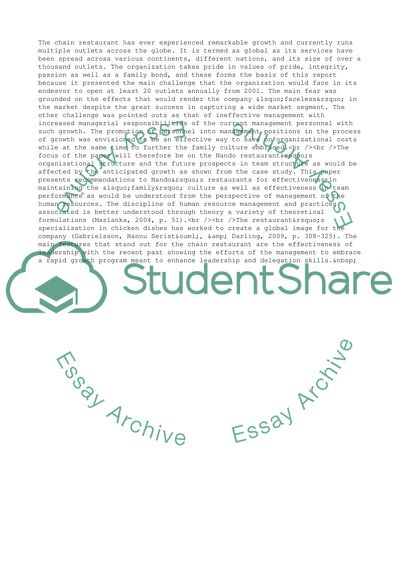Cite this document
(Effectiveness in Team Performance in Nandos Restaurant Case Study Example | Topics and Well Written Essays - 1750 words, n.d.)
Effectiveness in Team Performance in Nandos Restaurant Case Study Example | Topics and Well Written Essays - 1750 words. https://studentshare.org/management/1815442-produce-a-report-outlining-recommendations-based-on-team-and-leadership-theories-on-how-effective-team-performance-and-family-culture-can-be-achieved-in-nandos-under-the-circumstances-described-in-the-case-study
Effectiveness in Team Performance in Nandos Restaurant Case Study Example | Topics and Well Written Essays - 1750 words. https://studentshare.org/management/1815442-produce-a-report-outlining-recommendations-based-on-team-and-leadership-theories-on-how-effective-team-performance-and-family-culture-can-be-achieved-in-nandos-under-the-circumstances-described-in-the-case-study
(Effectiveness in Team Performance in Nandos Restaurant Case Study Example | Topics and Well Written Essays - 1750 Words)
Effectiveness in Team Performance in Nandos Restaurant Case Study Example | Topics and Well Written Essays - 1750 Words. https://studentshare.org/management/1815442-produce-a-report-outlining-recommendations-based-on-team-and-leadership-theories-on-how-effective-team-performance-and-family-culture-can-be-achieved-in-nandos-under-the-circumstances-described-in-the-case-study.
Effectiveness in Team Performance in Nandos Restaurant Case Study Example | Topics and Well Written Essays - 1750 Words. https://studentshare.org/management/1815442-produce-a-report-outlining-recommendations-based-on-team-and-leadership-theories-on-how-effective-team-performance-and-family-culture-can-be-achieved-in-nandos-under-the-circumstances-described-in-the-case-study.
“Effectiveness in Team Performance in Nandos Restaurant Case Study Example | Topics and Well Written Essays - 1750 Words”. https://studentshare.org/management/1815442-produce-a-report-outlining-recommendations-based-on-team-and-leadership-theories-on-how-effective-team-performance-and-family-culture-can-be-achieved-in-nandos-under-the-circumstances-described-in-the-case-study.


